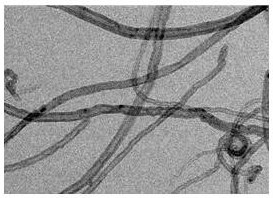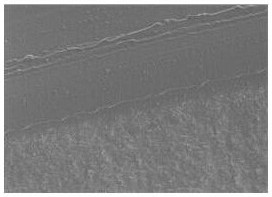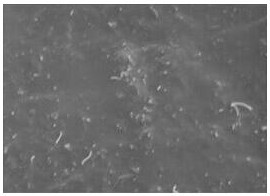Fabrication method of flexible and stretchable silicone rubber-based wearable strain-sensing fibers
A technology of strain sensing and silicone rubber, which is applied in fiber type, fiber treatment, textiles and papermaking, etc., can solve the problems of high production cost, high content of conductive filler, complicated preparation process, etc., and achieve low cost, high conductivity, The effect of excellent sensing performance
- Summary
- Abstract
- Description
- Claims
- Application Information
AI Technical Summary
Problems solved by technology
Method used
Image
Examples
preparation example Construction
[0026] A method for preparing a flexible and stretchable silicone rubber-based wearable strain-sensing fiber, comprising the following steps:
[0027] Step 1, use silane coupling agent in toluene solvent protected by nitrogen atmosphere to reflux at 60~100°C for 12~24h to modify the surface of hydroxyl multi-walled carbon nanotubes, vacuum filter and wash, then place in an oven at 60~80°C dry in medium for 3-8 hours to obtain functionalized modified multi-walled carbon nanotubes;
[0028] The silane coupling in step 1 is one of KH550, KH560, and KH570.
[0029] The concentration of the silane coupling agent in the toluene solution in step 1 is 2-8g / L.
[0030] Step 2, take silicone rubber component A (vinyl-terminated polydimethyl-methylvinylsiloxane) and silicone rubber component B (polydimethyl-methylhydrogensiloxane and platinum catalyst), According to the mass ratio of 8:1~12:1, magnetically stir for 10~40min until the mixture is uniform, degas the precursor mixture for ...
Embodiment 1
[0035]Use KH550 silane coupling agent (concentration: 8g / L) in a toluene solvent protected by nitrogen atmosphere at 60°C for 24h at reflux to modify the surface of hydroxyl carbon nanotubes, vacuum filter and wash, then place in an oven at 60°C Dry for 8 hours to obtain functionalized modified multi-walled carbon nanotubes; respectively weigh 5 g of silicone rubber component A (vinyl-terminated polydimethyl-methylvinylsiloxane) and component B (polydimethylvinylsiloxane) base-methylhydrogensiloxane and platinum catalyst) 0.420g magnetic stirring for 10min to mix evenly, degas the precursor mixture in a vacuum oven for 10min until there are no bubbles in the precursor mixture; inject the precursor mixture into a PTFE with an inner diameter of 2mm In a vinyl tube, cure in an oven at 60°C for 3 hours to obtain a transparent, bubble-free and smooth-surfaced silicone rubber fiber; weigh 2g of silicone rubber component A (vinyl-terminated polydimethyl-methylvinylsiloxane) Dissolve ...
Embodiment 2
[0037] Use KH560 silane coupling agent (concentration: 4g / L) in a toluene solvent protected by nitrogen atmosphere at 80°C for 18h at reflux to modify the surface of hydroxyl carbon nanotubes, vacuum filter and wash, then place in an oven at 70°C Dry for 6 hours to obtain functionalized modified multi-walled carbon nanotubes; respectively weigh 5 g of silicone rubber component A (vinyl-terminated polydimethyl-methylvinylsiloxane) and component B (polydimethylvinylsiloxane) base-methylhydrogensiloxane and platinum catalyst) 0.5g magnetic stirring for 20min to mix evenly, degas the precursor mixture in a vacuum oven for 20min until there are no bubbles in the precursor mixture; inject the precursor mixture into a PTFE with an inner diameter of 2mm In a vinyl tube, cure in an oven at 70°C for 2 hours to obtain transparent, bubble-free and smooth silicone rubber fibers; weigh 3g of silicone rubber component A (vinyl-terminated polydimethyl-methylvinylsiloxane) Dissolve in 40mL of ...
PUM
| Property | Measurement | Unit |
|---|---|---|
| concentration | aaaaa | aaaaa |
| tensile strength | aaaaa | aaaaa |
| electrical conductivity | aaaaa | aaaaa |
Abstract
Description
Claims
Application Information
 Login to View More
Login to View More - R&D
- Intellectual Property
- Life Sciences
- Materials
- Tech Scout
- Unparalleled Data Quality
- Higher Quality Content
- 60% Fewer Hallucinations
Browse by: Latest US Patents, China's latest patents, Technical Efficacy Thesaurus, Application Domain, Technology Topic, Popular Technical Reports.
© 2025 PatSnap. All rights reserved.Legal|Privacy policy|Modern Slavery Act Transparency Statement|Sitemap|About US| Contact US: help@patsnap.com



